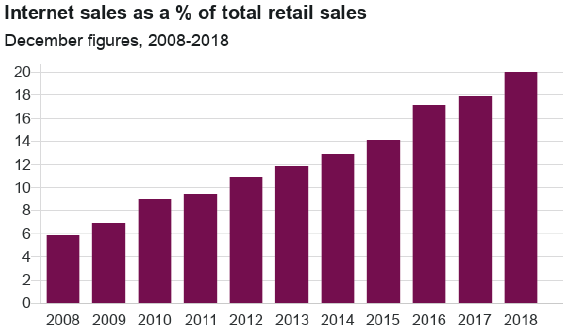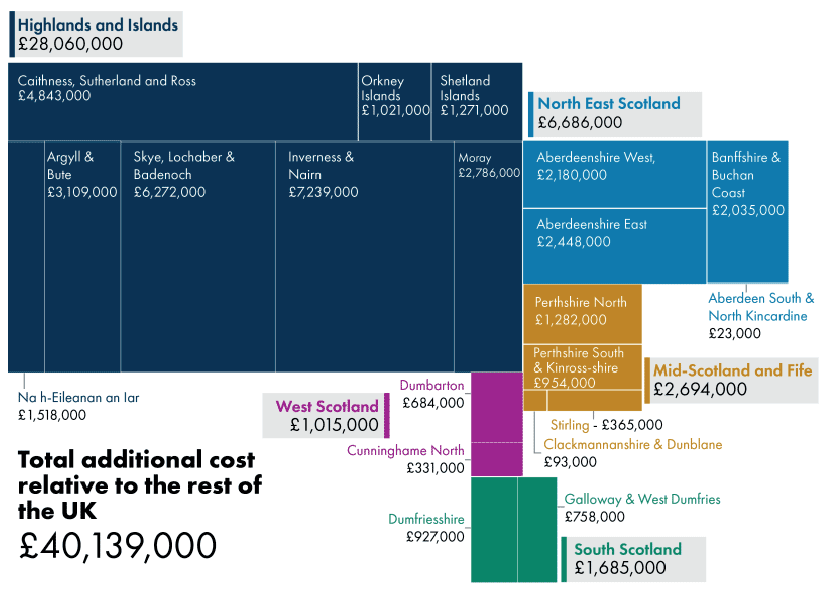Statement of principles for parcel deliveries: review
In November 2018, the Scottish Government launched the Fairer Deliveries For All: An Action Plan which listed eight key actions to tackle the unfair and discriminatory parcel delivery charges faced by communities in remote and rural Scotland. This report is in response to action point 4.
2. Setting the Context
This chapter sets the scene for the research. It is important to acknowledge that the issue of non-proportionate or unfair parcel delivery surcharging is long-standing, and one that continues to be a source of frustration and public concern for residents and businesses alike, especially in rural and remote areas of Scotland.
Indeed, there is a growing body of evidence that provides the views, experiences, perspectives and potential solutions from all sides - consumers, retailers and parcel operators. We have undertaken a rapid review of the existing evidence base, and provide a summary of the main issues and steps undertaken by the Scottish Government and key players to help raise awareness of and tackle the issue.
2.1 Increasing Popularity of Online Shopping
The prominence of parcel delivery surcharging has grown in parallel with the importance of ecommerce across the UK. Over the last decade, online purchases have grown from around 5% of total retail sales in the UK to almost 20%,[7] Figure 2.1. This shows the increasing and continuing popularity of online shopping among UK consumers. This is a trend that looks set to continue.

Source: Office for National Statistics
Source: BBC, High Street crisis: Can 'click and collect' save shops?, 25th January 2019.
Scottish consumers are just as likely to shop online as consumers living in other parts of the UK. The Scottish Government has estimated that ecommerce in Scotland generated some £26.4 billion in online sales (2016).[8]
In remote and rural areas the availability of online shopping for groceries and other goods can be a vital lifeline. The overall cost of living in these areas is higher than in urban areas - for example, groceries and other goods typically cost more to buy locally. Online shopping provides consumers living in these communities with the advantage of buying online, greater choice, and the opportunity to buy cheaper products.[9]
More and more businesses are opting to sell online. This includes those with a physical presence and new businesses which only sell online. Sites such as Amazon, eBay, Etsy, and Not On The High Street provide ways for small businesses to access customers without maintaining their own web infrastructure - the evidence shows that the number of sellers on these sites and overall sales have grown substantially over recent years.[10]
A recent report found that the average UK shopper spends £226 online in a three-month period (2019).[11] Clothing continues to be the most popular item purchased online. This is followed by food or drink, books, footwear, and toiletries and make-up. The same report highlights the following key points:
- most online shoppers were satisfied with their last delivery (93%);
- Royal Mail is the dominant brand in the delivery market - 74% said they trust the Royal Mail (nearest competitor - 41%);
- 66% would be more likely to use a retailer if Royal Mail was the delivery operator;
- delivery time windows, delivery updates, and the ability to track delivery are key factors - people are living busier lives, and so consumers want deliveries to fit around their schedules (rather than the other way about);
- home delivery is the preferred option (66%), followed by the Post Office; and
- the growing popularity of click and collect - more than half use click and collect (55%), largely because it is free (i.e. avoiding delivery charges) or it is more convenient.
"I was just browsing" is the main reason for not making an online purchase (39%). However, delivery charges continues to be an important factor (36%).
Free delivery is the most important consideration in choosing certain retailers (44%). This is followed by lowest price and the returns policy.
Royal Mail, Delivery Matters UK - Understanding Online Shopper Behaviour, 2019.
2.2 Consumers and Areas Affected
Citizen Advice Scotland (CAS) research has estimated that at least one million Scottish consumers face surcharges, late delivery, or are even refused delivery when they try to make an online purchase (2012).[12]
Key factors at play are logistics and the nature of Scotland's geography. Distance travelled for parcel delivery companies, and the fact that Scotland is categorised by some sparsely populated areas, long distances between delivery points, and difficult terrain/access in places results in potential cost-related issues when the lower volume of parcels is taken into account.
The use of third-party couriers is also highlighted within the existing research (and supported by some of the small businesses and stakeholders consulted as part of this research) to be a factor in driving up costs. Indeed, much of the existing evidence base considers what is termed the "drop density" and "last mile" issue.
Consumers living in the Highlands and Islands of Scotland and other remote areas are often reported in the existing evidence base to be most acutely affected by unfair and excessive parcel delivery surcharging. Much of the research refers to the Highlands and Islands in very broad terms - the definition of Highlands and Islands is typically said to vary from one retailer to another. For example, it can often include the Highland authority area, Scottish islands, and parts of Angus, Aberdeen City or Shire, Perthshire, Stirling and Clackmannanshire, etc.
The misclassification of postcodes continues to be a source of much frustration for consumers and smaller businesses (e.g. addresses recorded as being on an island when they are on the mainland). This has resulted in consumers living in these areas experiencing a higher cost for parcel delivery - on average 30% higher than for other areas of Great Britain (and higher still for island addresses).[13] Consumers living in the Highlands and Islands are therefore paying a "premium" for home delivery compared to consumers living in urban and less remote areas.
2.3 What are the Issues Faced by Scottish Consumers
The main issues that consumers living in affected areas of Scotland have faced over the years are typically reported as follows:
- being charged extra because of where they live (and more specifically their postcodes);
- "free UK delivery" and "next day delivery" claims on retailers websites - but many consumers that live in remote areas are then excluded;
- surcharges added at the end of the online buying process (or after the sale has been completed) - online retailers market goods/services at an attractive price to gain interest which hides the real price for consumers living in rural and remote communities (e.g. unclear and misleading claims);
- high, disproportionate, and/or at times inconsistent surcharges;
- longer, slower delivery times; and
- no delivery available to some remote or rural areas.[14]
With the continued growth in online shopping, the implications and knock-on effects for consumers living in (or indeed considering moving to) rural and remote areas in Scotland are clear, Figure 2.2.
Figure 2.2: Implications of Parcel Delivery Charges for Consumers
Implications
Adds additional cost to goods and services.
Makes price comparisons difficult.
Reduces and restricts choice.
Might exclude some consumers from making the purchase altogether.
Wider knock-on effects
Reduced consumer confidence and trust in online shopping.
Increased consumer complaints.
Lower levels of consumer satisfaction.
Reduced online shopping levels.
Research has shown that additional costs can often depend on the products on sale, the weight of the item, how they are delivered, and where products are delivered to. Many different factors are affecting online delivery surcharges: type and size of retailer, lack of control over delivery costs, size and weight of item, parcel operators used, and handling charges.[15]
2.4 The Issue Affects Scottish Businesses Too
There are almost 15,000 businesses based in remote and rural areas of Scotland,[16] and the vast majority are small or micro businesses. It would be fair to assume that most are likely to regularly order items online for business use, while many will also sell goods online.
CAS published research in 2014 into the experience and impact of online delivery costs on businesses' day-to-day operations. The research found that:[17]
- almost 90% of businesses that responded to the survey regularly faced an additional surcharge for delivery due to their location;
- misleading claims of free delivery, issues of being classed as "offshore" or "remote" (when this was not necessarily the case), and delays in delivery were all commonplace;
- the majority of suppliers did not offer delivery by Royal Mail as an option - and so the Universal Service Obligation does not apply to many items ordered by rural businesses. Further, the general view was that many sellers were unwilling or unable to depart from their standard carrier arrangements (e.g. exclusive arrangements with specific couriers);
- 86% would be happy to collect items from their local Post Office if the cost of delivery could be reduced; and
- 76% felt that the costs of ordering online had a substantial impact on their business - decisions to be made around whether they absorb high delivery costs (i.e. lowering profit) or pass the cost onto customers (i.e. competitive disadvantage).
2.5 An Issue That Has Not Gone Away
While the issue has not gone away, updated research published by CAS (2015)[18] has highlighted where some progress and traction have been made:
- fewer retailers add a surcharge compared to three years ago (from 50% in 2012 to 44% in 2015 - Highlands; from 62% to 53% for Island residents);
- fewer retailers now refuse to deliver to remote areas; and
- online retailers are better at complying with regulations (e.g. improved clarity and availability of online delivery information).
That being said, the same research also found an increase in the number and level of delivery surcharges.
There is recognition within the evidence base that higher retail costs are inevitably a common feature associated with living in remote and rural areas. This is largely because goods are more expensive to transport to these areas - e.g. extra fuel costs, ferry costs, and costs arising from the return leg being empty.
From a review of the research, the main issue yet to be resolved is around the extent to which delivery charges to certain areas are fairly and transparently set as opposed to arbitrary (and therefore disproportionate to the actual cost).
2.6 Estimating the Additional Cost to Scotland
In terms of the financial impact, the Scottish Parliament Information Centre (SPICe) has estimated that the additional cost to Scottish consumers of parcel delivery surcharges has increased year on year, from £36.3 million (2017) to £38 million (2018)[19] and to £40.1 million (2019).[20]
SPICe has also produced a breakdown of this by Scottish Parliament constituency - see Figure 2.3.

Source: SPICe. Figures may not sum due to rounding.
A Scottish Parliament Members Business debate was held in December 2019 and reaffirmed the issues described above. MSPs expressed their continued frustration with unfair delivery charges, while recognising the steps that have been taken by a range of organisations over recent years to tackle it.[21]
Contact
There is a problem
Thanks for your feedback